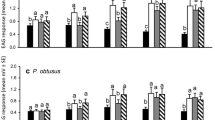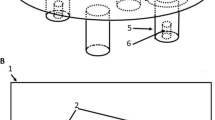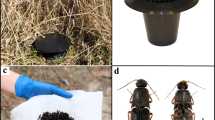Abstract
The little fire ant, Wasmannia auropunctata (Roger) (Hymenoptera: Formicidae), is an invasive ant with negative impacts on both biodiversity and agriculture throughout the tropics and subtropics. Field experiments were conducted in order to elucidate the relative attractiveness of the enantiomers of the alarm pheromones, 2,5-dimethyl-3-(2-methylbutyl)pyrazine and 3-methyl-2-(2-methylbutyl)pyrazine. The enantiomers tested were synthesized from commercially available (S)-2-methylbutan-1-ol or kinetically resolved (R)-2-methylbutan-1-ol, prepared using Pseudomonas cepacia lipase (PCL). Bioassays conducted in a macadamia orchard on the island of Hawaii demonstrated that W. auropunctata were preferentially attracted to the (S)-enantiomers of both alkyl pyrazines over the racemic mixtures in all experiments. To our knowledge, this is the first instance of differential attraction of ants to the enantiomers of chiral pyrazine pheromones despite many examples of these compounds in the literature. In addition, using a chiral column it was determined that (S)-2,5-dimethyl-3-(2-methylbutyl)pyrazine and (S)-3-methyl-2-(2-methylbutyl)pyrazine are the only enantiomers produced by W. auropunctata.





Similar content being viewed by others
References
Bestmann HJ, Liepold B, Kress A, Hofmann A (1999) (2S,4R,5S)-2,4-dimethyl-5-hexanolide: ants of different species Camponotus can distinguish the absolute configuration of their trail pheromone. Chem Eur J 5:2984–2989
Brophy JJ (1989) Pyrazines obtained from insects: their source, identification, synthesis and function. In: Atta-ur-Rahman (ed) Studies in natural products chemistry: structures and elucidation. Elsevier, Amsterdam, pp 221–273
Brown WV, Moore BP (1979) Volatile secretory products of an Australian formicine ant of the genus Calomyrmex (Hymenoptera: Formicidae). Insect Biochem 9:451–460
Conant P (2000) Wasmannia auropunctata (Hymenoptera: Formicidae): established on the island of Hawai’i. Bishop Mus Occas Pap 64:21
de Souza ALB, Delabie JHC, Fowler HG (1998) Wasmannia spp. (Hym., Formicidae) and insect damages to cocoa in Brazilian farms. J Appl Entomol 122:339–341
Derstine NT, Troyer EJ, Suttles CN, Siderhurst LA, Jang EB, Siderhurst MS (2012) Field trapping little fire ant, Wasmannia auropunctata (Roger). J Insect Sci 12:93. Available online: http://www.insectscience.org/12.93
Ghanem A, Aboul-Enein HY (2005) Application of lipases in kinetic resolution of racemates. Chirality 17:1–15
Heinsman NWJT, Marcelis CLM, De Sousa TA, Franssen MCR, De Groot A, Van Der Padt A, Orrenius SC, Jongejan JA (1998) Lipase mediated resolution of γ-branched chain fatty acid methyl esters. Biocatal Biotransfor 16:145–162
Heinsman NWJT, Riet KV, Franssen MCR, Van Der Padt A, Boom RM, De Groot A (2002) Lipase-mediated resolution of branched chain fatty acids. Biocatal Biotransfor 20:297–309
Holldobler B, Oldham NJ, Morgan ED, Konig WA (1995) Recruitment pheromones in the ants Aphaenogaster albisetosus and A. cockerelli (Hymenoptera: Formicidae). J Insect Physiol 41:739–744
Janssen E, Uebler E, Bauriegel L, Kern F, Bestmann HJ, Attygalle AB, Steghaus-Kovac S, Maschwitz U (1997) Trail pheromone of the ponerine ant Leptogenys peuqueti (Hymenoptera: Formicidae): a multicomponent mixture of related compounds pheromones 104 (1). Naturwissenschaften 84:122–125
Jourdan H, Bonnet de Larbogne L, Chazeau J (2002) The recent introduction of the neotropical ant Wasmannia auropunctata (Roger) into Vanuatu archipelago (Southwest Pacific). Sociobiol 40:483–509
Kumada M, Tamao K, Sumitani K (1978) Phosphine-nickel complex catalyzed cross-coupling of Grignard reagents with aryl and alkenyl halides: 1,2-dibutylbenzene. Org Synth 58:127–133
Le Breton J, Chazeau J, Jourdan H (2003) Immediate impacts of invasion by Wasmannia auropunctata (Hymenoptera: Formicidae) on native litter ant fauna in a New Caledonian rainforest. Austral Ecol 28:204–209
Lowe S, Browne M, Boudjelas S (2000) 100 of the world’s worst invasive alien species. Aliens 12:S1–S12
Morgan ED (2009) Trail pheromones of ants. Physiol Entomol 34:1–17
Morgan ED, Do Nascimento R, Keegans S, Billen J (1999) Comparative study of mandibular gland secretions of workers of ponerine ants. J Chem Ecol 25:1395–1409
Mori K (2007) Significance of chirality in pheromone science. Bioorg Med Chem 15:7505–7523
Mori K (2009) Pheromone synthesis. Part 240: Cross-metathesis with Grubbs I (but not Grubbs II) catalyst for the synthesis of (R)-trogodermal (14-methyl-8-hexadecenal) to study the optical rotatory powers of compounds with a terminal sec-butyl group. Tetrahedron 65:3900–3909
Oldham NJ, Keegans SJ, Morgan ED (1994) Mandibular gland contents of a colony of the queenless ponerine ant Dinoponera autralis. Naturwissenschaften 81:313–316
Olubajo O, Duffield RM, Wheeler JW (1980) 4-Heptone in the mandibular gland secretion of the Nearctic ant, Zacryptocerus varians (Hymenoptera: Formicidae). Ann Entomol Soc Am 73:93–94
Parry K, Morgan ED (1979) Pheromones of ants: a review. Physiol Entomol 4:161–190
Riley RG, Silverstein RM, Moser JC (1974) Biological responses of Atta texana to its alarm pheromone and the enantiomer of the pheromone. Science 183:760–762
Sasaerila Y, Gries R, Gries G, Khaskin G, King S, Chor BT (2000) Decadienoates: Sex pheromone components of nettle caterpillars Darna trima and D. bradleyi. J Chem Ecol 26:1969–1981
Sato N, Matsuura T (1996) Studies on pyrazines. Part 32. Synthesis of trisubstituted and tetrasubstituted pyrazines as ant pheromones. J Chem Soc, Perkin Trans 1:2345–2350
Showalter DN, Troyer EJ, Aklu M, Jang EB, Siderhurst MS (2010) Alkylpyrazines: alarm pheromone components of the little fire ant, Wasmannia auropunctata (Roger) (Hymenoptera, Formicidae). Insectes Soc 57:223–232
Smith MR (1965) House-infesting ants of the eastern United States: their recognition, biology, and economic importance. U.S. Dept. of Agriculture, Washington, DC
Spencer H (1941) The small fire ant Wasmannia in citrus groves: a preliminary report. Fla Entomol 24:6–14
Tecle B, Sun C-M, Brophy J, Toia R (1987) Novel pyrazines from the head of Australian ponerine ant Rhytidoponera metallica. J Chem Ecol 13:1811–1822
Tentschert J, Bestmann HJ, Hölldobler B, Heinze J (2000) 2,3-Dimethyl-5-(2-methylpropyl)pyrazine, a trail pheromone component of Eutetramorium mocquerysi Emery (1899) (Hymenoptera: Formicidae). Naturwissenschaften 87:377–380
Troyer EJ, Derstine NT, Showalter DN, Jang EB, Siderhurst MS (2009) Field studies of Wasmannia auropunctata alkylpyrazines: towards management applications. Sociobiol 54:955–971
Ulloa-Chacón P, Cherix D, Meier R (1991) Bibliografía de la hormiga colorada Wasmannia auropunctata (Roger) (Hymenoptera: Formicidae). Notic Galápagos 50:8–12
Vander Meer RK, Alonso LE (1998) Pheromone directed behavior in ants. In: Vander Meer RK, Breed MD, Espelie KE, Winston ML (eds) Pheromone communication in social insects-ants, wasps, bees, and termites. Westview Press, Boulder, pp 159–192
Walker KL (2006) Impact of the little fire ant, Wasmannia auropunctata, on native forest ants in Gabon. Biotropica 38:666–673
Wang Y, Wang R, Li Q, Zhang Z, Feng Y (2009) Kinetic resolution of rac-alkyl alcohols via lipase-catalyzed enantioselective acylation using succinic anhydride as acylating agent. J Mol Catal B: Enzym 56:142–145
Wetterer JK (1997) Alien ants of the Pacific islands. Aliens 6:3–4
Wetterer JK, Porter SD (2003) The little fire ant, Wasmannia auropunctata: distribution, impact and control. Sociobiol 41:1–41
Wetterer JK, Walsh PD, White LJT (1999) Wasmannia auropunctata (Roger) (Hymenoptera: Formicidae), a destructive tramp-ant, in wildlife refuges of Gabon. Afr Entomol 7:1–3
Yu Y, Plettner E (2013) Enantiomer and conformer recognition of (+) and (−)-disparlure and their analogs by the pheromone binding proteins of the gypsy moth, Lymantria dispar. Bioorg Med Chem 21:1811–1822
Author information
Authors and Affiliations
Corresponding author
Rights and permissions
About this article
Cite this article
Yu, Y., Jang, E.B. & Siderhurst, M.S. Differential Field Responses of the Little Fire Ant, Wasmannia auropunctata (Roger), to Alarm Pheromone Enantiomers. J Chem Ecol 40, 1277–1285 (2014). https://doi.org/10.1007/s10886-014-0516-z
Received:
Revised:
Accepted:
Published:
Issue Date:
DOI: https://doi.org/10.1007/s10886-014-0516-z




